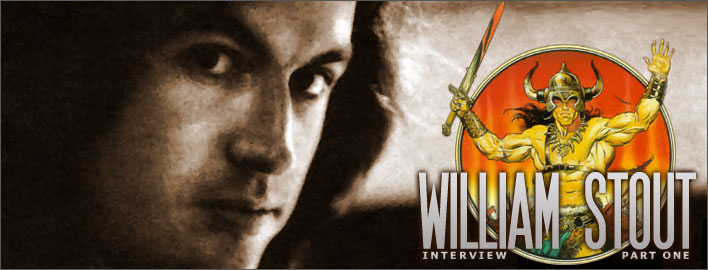 |
| 6 |
|
| |
- Could you please tell us when and how exactly you ended up working on CONAN THE BARBARIAN? I think I read a lot of other artists were considered before you got the job, with some "big names" amongst them...
- Richard Corben was offered the job of storyboarding the CONAN film first. He did a sample page which was fantastic. Then he got Dino DeLaurentiis' contract, read it, rejected it and then flew back home. Richard didn't realize that the first contract you get is not written in stone; it's actually a first offer — the beginning of a negotiation.
In regards to the path of my own involvement: I had this friend Bob Greenberg, who was working for Ed Pressman, the original producer for CONAN. Bob knew I was a big Conan fan. I loved all of the Robert E. Howard stories and the Frazetta covers and the related stuff. He told me I really should come by and see what Ron Cobb was doing on CONAN. At the time, Ed had hired Ron to do presentation illustrations to begin to visually define the film. This was before Milius was attached to it, back when Oliver Stone was going to direct it. I told Bob I'd love to except that at the time I had never been busier in advertising. I was doing so many movie posters it was just unbelievable. There was just no time to take a break to see Ron's CONAN work.
Finally, my schedule lightened up a bit. I didn't go over to the CONAN offices, though. Instead, I went to the ABA, which was the national book fair. It was an event where every publisher in the United States gathered in one spot — a great way for illustrators to get work. You could bring your portfolio and walk from booth to booth and show your work and get hired. I had my portfolio with me, and who should I run into at the book fair but Ron Cobb himself. He said that I was his first choice of someone to work with on the film. I don't know how he was aware of my work, or whether it was just my portfolio that impressed him on the spot. But he said he had an arrangement with John Milius, who was now the director of the film, that whoever Ron hired John had veto power over; whoever John hired to work for Ron, Ron had veto power over. So I had to show my stuff to John; Ron asked me if I would come to the office and drop off my book.
I agreed; it sounded like fun. I was a huge admirer of Ron Cobb's work. He did most of the important underground political cartoons in the 1960s for the L.A. Free Press. Ron is an amazing artist with an amazing mind. He invented the ecology symbol and donated it to the public domain.
I went in to the CONAN offices on a Friday. I was just going to drop off my book, but Milius was there. I handed it directly to him. I watched as he looked through it. He remembered the Harlan Ellison story I had illustrated for Heavy Metal, "Shattered Like A Glass Goblin." He had really liked that story. I also had my work for my Dragon Slayers portfolio with me, and he really liked that as well. John handed my work back to me and started to walk out of the room. John's a really dramatic, charismatic guy. As he was walking out the room, over his shoulder he barked, "Hire him!" — just like out of a western!
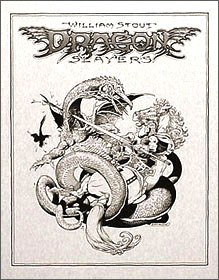 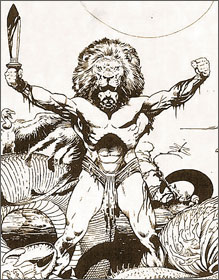 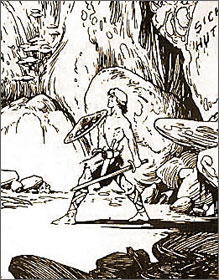
I went into the producer's office to talk to Buzz Feitshans, the line producer for the show. Our receptionist was Kathleen Kennedy, if you can imagine. Just a couple of years later she produced E.T.! Buzz told me what they were going to be paying me to do storyboards for the film. I nearly fell off my chair laughing, because it was about 10% of what I was making in advertising. I'd been doing advertising for movies for awhile; I ended up doing the advertising for over 120 films.
But I thought this might be fun for a couple of weeks. Well, the two weeks turned into two years. It was an interesting time to get into making motion pictures. John was just finishing his production duties on 1941, which Spielberg directed. We were all sharing offices. So Ron Cobb and I would work on CONAN during the day, and then put down our pencils at 6:00 and run across the hall to Steven's office and kick around ideas for RAIDERS OF THE LOST ARK in the evening. It was just one big exciting happy family there.
We were in those offices for a good chunk of a year, maybe less. Then we moved to Dino DeLaurentis' offices in Beverly Hills. That was a whole other experience meeting the DeLaurentis family and dealing with them as producers.
Because of CONAN, my film career was pretty much launched. When I first started working on CONAN, I began doing traditional storyboards. John Milius came in and said, "No. No. No. I don't want you to do them like that. I want you to do them like a comic book. Just do them the way you would if you were adapting my screenplay to comics. That's the way I want to see it." That's why my storyboards for the film look like comic book pages.

As I was drawing the pages I began realizing that I had better pay close attention to the architecture and the costumes. I started designing costumes for each character that was appearing within the comic. I then decided I had better design the armor for the horses, too. As a result, these pages were taking forever to finish. Basically, I was production designing a significant aspect of the film within those pages rather than just banging out storyboard panels. So I only finished about ten or a dozen pages. About that time I kept looking at what Ron Cobb was doing. I thought, Ron's really got the fun job, designing the sets and costumes by doing single illustrations. I thought that would be a far more effective use of my time. I pitched that to Ron, and he said, "You know what? You can design whatever I don't have time to design. We'll work that way."
I didn't realize that I was eventually being given the knowledge and on-the-job training to become a production designer with my very first movie gig. The production company was really happy because I was producing a lot more pictures now, not just one page every week or two. They were getting more bang for their buck. That's why I stopped doing those storyboard pages and began working directly as a designer on the film. I got to do even more design work on the second movie.
- To my knowledge, the Richard Corben piece was never published... Just out of curiosity, do you remember what was represented on his sample page?
- It was the opening of the film: the making of Conan's sword. Beautiful work; crystal clear yet atmospheric storytelling.
- I read that very early on (I think it was back in 1977), John Buscema roughed out a number of pre-production drawings based on a script written by Ed Summer and Roy Thomas (this was long before John Milius was involved). Did you ever see these drawings? Or any other piece from any other artist, done for the movie, pre-dating your involvement (and Ron Cobb's)?
- I never saw any work other than Corben's, Cobb's and mine. Neal Adams did some boards, too (on spec). For legal reasons I was never allowed to see Neal's speculative work for CONAN (Neal eventually showed them to me after the film was completed). Dino licensed Frazetta's Conan the Adventurer image for the film's earliest teaser poster (of course I was very familiar with Frank's Conan work).
- I assume the Oliver Stone screenplay had already been dropped at the time when you were first involved in the project, right? But were you still granted access to it? Did you ever read it? Or did you only worked on the various subsequent John Milius drafts?
- The only screenplay I ever saw was John's. He wrote it and gave Ron and I pages each day as we worked designing what he had already written. It was very exciting, getting those pages each day! From what I read, other than a large Shadizar sequence, very little changed from the first draft to the screen version. There was some gruesome stuff that John threw into the screenplay intentionally knowing it would never make the final cut — so that Dino DeLaurentiis would have something to cut from the script, making Dino feel like a creative participant in the filmmaking process.
I heard about the Stone screenplay from my friend Rick Baker. It sounded completely unrealistic as a film project.
- Could you possibly tell me more about this cut Shadizar sequence?
- That was over 20 years ago so I'm afraid I don't recall the story specifics. I just recall fuming with anger in the art room while Ron Cobb was in the next room desperately fighting to keep Shadizar against the wishes of the producers.
I don't believe I still have a copy of that early script. As the script changed, we just discarded the old pages, replacing them with the new ones.
- Could this possibily be related to the fact that Ron Cobb originally wanted to actually build the whole city from the ground up (instead of "redressing" available parts of already existing old towns), an option the producers may have considered too expensive at the time?
- The producers just wanted Shadizar (or most of it, anyway) out. They did not share the vision of John Milius, Ron Cobb or myself.
Shadizar was indeed going to be a major set show piece of the movie — just as it was indicated in the script. Ron is maybe the smartest guy I know. I'm sure he would have had no problem with redressing an existing location if it came to that. This was my first major film. I later learned from experience on lots more movies that cutting something like Shadizar was typical. About a third of the sets (or more) get cut from nearly every film.
- Speaking of that, how restrictive was the film budget, on a purely creative/artistic level? Did the budget fluctuate a lot?
- Those would be questions for Ron. Since this was my first major film, I wasn't involved very much at all in the budget. I learned a lot about how to save money on a film from Ron, which came in very handy when I became a production designer.
|
|
|
| |
|
- Do you remember conceptual ideas that were scaled down or discarded, because of budgetary reasons? I read that Milius originally intended to have a massive spectacular battle scene at the end of the movie, involving huge armies and thousands of warriors on horseback!
- Other than Shadizar, I don't recall any major cuts. John might have wanted armies (what director doesn't?) or he might have written them into the script to give Dino something to take out. I don't recall. It's doubtful because the final battle was an homage of sorts by John to the final battle in Kurosawa's SEVEN SAMURAI — which did not involve armies; just seven guys, some peasants and a brigade of heavily armed bandits.
I do recall that in the Oliver Stone script there was a scene in which there were 20,000 demons — each in a highly detailed full body suit by Rick Baker, no less — an impossible scene to shoot at that time. |
|
|
|
 |
|
|
|
|
|
- John Milius supposedly wrote three - possibly four?- different drafts of the screenplay, but information sources are rather contradictory... Do you know and could you tell us exactly how many drafts he produced and what were the main differences/evolutions between those drafts?
- I don't know how many drafts there were but as I said: there were no signicant changes from John's first draft to his shooting script. There were huge changes, however, from Oliver Stone's version to John's version. Basically, John kept the title of the film and the names of some of the characters.
- You just mentioned THE SEVEN SAMURAI, which was an obvious and outspoken visual reference on the final movie. I assume Milius specifically and repeatedly mentioned it during the pre-production process, to the extent of even getting the Kurosawa movie screened for some of the cast and crew members, right? (like he reportedly did with Richard Fleischer's THE VIKINGS too, and possibly a few other movies - KWAIDAN, ALEXANDER NEVSKY...)
- That's true.
- Do you remember more obscure visual references he liked and talked about, and got inspired by, or maybe wanted you and Ron Cobb to got inspired by?
- There was a huge "History of Japanese Cinema" film festival playing at a theater not far from our offices. I brought John a list of the films that were being shown. He made many of them mandatory viewing for Ron and me; our "homework", so to speak. I ended up seeing just about everything — even the ones not checked off by John. It was a tremendous education in the history of Japanese cinema.
- Any other specific movie scenes, paintings, artworks you would remember?
- I don't recall anything specific (other than what has already been mentioned: the body painting of KWAIDAN and the final battle scene of THE SEVEN SAMURAI) that directly influenced our CONAN film. Most of our visual inspiration came from historical sources. We wanted Conan's world to seem real.
- Same question, but now regarding/concerning your own visual inspiration(s) when you worked on the first CONAN (we'll talk about the second one later, which is a totally different animal...).
- Ron's main idea for our visualizing of CONAN was brilliant. We looked at architecture, furniture and objects from different ancient cultures. We studied how the design of things evolved. Then we "undesigned" them — we designed them backwards in time.
For instance, we might look at stuff from a certain period in ancient Egypt. Then we would look at what came before it. Then, we'd examine what came before that. When we finally hit an area that was not documented, using our imagination and observing the design patterns of the previous eras, we would visualy construct an earlier version of that culture. It was from our imagination but it was very historically based. We felt that by rooting Conan in some form of the ancient real world that the Hyborian age (and the fantasy elements within that world) would seem more real and believable.
- Your comment about "designing things backwards in time" makes me think about the original opening of the movie, that was showing a map of our world turning into a map of the Hyborian Age. I know for a fact that this was already in the Oliver Stone's draft; I think Milius liked the idea, because he used it too in his own screenplay, and you even boarded that sequence. But I was wondering... Was such an opening ever actually filmed?
- As far as I know, it wasn't. But I'm not the guy to ask because I left before filming to finish my dinosaur book.
- Was it, at least, planned to be filmed?
- I think it was originally planned to be filmed — otherwise I wouldn't have boarded it.
- I mean, did you create practical prop maps in order to be used in such a scene? Like the ones we see in the background of the War-Yurt tent scene, for example...
- Other than what I drew in my storyboards, I never created a prop map.
|
|
|
- While on this subject of the opening, I have this old Amra (Swordplay and Sorcery) magazine (Vol.2 #71), where you says "In fact, the bearded Conan only appears in the first minutes of the film. This is King Conan, reflecting on his past." Could you possibly tell me a little bit more about that?
- Man, I'm really sorry but I don't remember. The cast and crew screening cut might have had the old King Conan at the beginning — or, I could have just been confused at the time of the interview, incorrectly remembering the King Conan sequence at the beginning instead of at the end of the film. I did design it, though.
- Was the map-opening idea filmed, then scrapped and replaced by a King-Conan-opening, which was filmed then itself scrapped and replaced by... nothing, considering the movie now opens on, purely and simply, a black screen?
- That's a question for either Cobb or Milius.
- There are conflicting reports about the King Conan footage that actually shows up at the end of the movie, too: some say this footage comes from some unused teaser trailer, others say it was originally used as the opening of the movie by Milius...
- Either could be true or false... Sorry! I vaguely remember a King Conan teaser trailer but I certainly could be mistaken. Man, you ask some tough ones! |
|
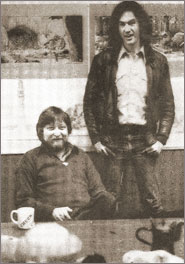 |
|
|
|
- In this Comic Art interview (from 1996), you are quoted as saying "...when I was more involved in the production design of films, I'd meet everybody who came in for casting and stuff. You know, when I was working on CONAN, Nick Nolte came in, and Jack Palance, and Joe Don Baker..." Do you remember for which part/role/character each of these three actors were considered? I assume Palance was up for the Conan's father role, right?
- Yes. He pushed heavily for the lead (the role of Conan himself), though. Had he been a younger man he would have been absolutely perfect. I suggested both Jack Palance and William Smith for the film. On my first day of work, I put a picture of William Smith on my drawing board with the notice: "This guy has got to be in the film!" Both Smith and Palance are terrific actors with great bone structure. They both looked like they belonged in a CONAN movie.
- What about the two others? Thulsa Doom's henchmen maybe?
- I think that Nick Nolte was just keeping in touch. By doing so he ended up starring in Milius' FAREWELL TO THE KING and EXTREME PREJUDICE. Joe Don Baker might have been considered for Conan's father as well; I believe he was. Or, he may have been keeping in touch. Another really good actor and a big, brawny, scary guy — on film, that is. In person, he's very kind and thoughtful.
- By any chance, do you remember any other actor or actress names that was auditioned or considered for a part in the first CONAN movie?
- Christopher Lee (and his voice) came in for Thulsa Doom — but what he really wanted was access to Spielberg for a role in RAIDERS OF THE LOST ARK. As Milius was Steven's producer for 1941, Steven's office was across the hallway from the art department.
Two Bob Fosse dancers, Ann Reinking and Sandahl Bergman, were considered for the role of Valeria (on Fosse's recommendation). Irene (MIDNIGHT EXPRESS) Miracle auditioned for the role of the princess. Roy Jenson gave a great audition for the part of Red Hair. He's been in other Milius films, including DILLINGER and RED DAWN. Frank McRae came in as well, either to read for Thulsa Doom or just to keep in touch. He's worked in a lot of Milius films. Frank is another very kind, sweet man who often gets cast as a big, scary guy.
- According to what I read, Frank McRae was up for the role of Yaro, a huge black priest who was originally supposed to be the High Priest in the Tower of the Serpent sequence (according to one of Milius' drafts of the script, Yaro also was supposed to be part of the King Osric's death scene, and he was fighting with Conan in the Orgy Chamber).
- I think you're right about this.
- Someone once told me that Aldo Sambrell (the Spanish actor who was finally hired to play the Yaro character) didn't show up for work the day his scene was to be shot, so Milius fired him on the spot and had Ben Davidson fill in the scene as Rexor... But I don't know whether this story is true!
- I wasn't there for the shooting, so I don't know.
- OK, here are some other names that I found in various old magazines, all attached to the first CONAN movie at some point or another, let me know if any of these names rings any bell to you: Sean Connery?
- The role of Thulsa Doom was originally written for Sean Connery. Sean passed. You have to realize that every major actor considered for a role is nearly always told the lie that the role was written just for them. In Sean's case, though, this was true. After Sean passed, I heard Milius tell James Earl Jones that Thulsa Doom was written just for him.
- John Huston?
- John was considered for Osric; he may have been John's first choice.
- I read that he was considered for the old Wizard part and possibly for the Thulsa Doom part, too...
- That's possible.
- Sterling Hayden?
- Another Osric possibility.
- Raquel Welch?
- Her name never came up while I was there, except for when a studio mogul John introduced me to made a nasty comment about her.
- I don't know if any of this is true or just rumors, but I read she was up for the Valeria part -- and maybe for the Princess part too, according to other sources...
- Valeria: maybe but unlikely. The Princess: she was already too old for that role.
- Persis Khambatta?
- Upon my recommendation, Persis was considered for the role of the Princess. I think in retrospect they wished that they had cast her.
- Lou Ferrigno?
- I think that Arnold would have resisted Lou to being in the film.
- Sylvester Stallone?
- I don't recall Sly being mentioned for CONAN...
- Dave Prowse?
- ...nor David Prowse.
- Also, John Milius said in this interview: "Well this famous Japanese actor wanted to be in Conan and his agent came in to make a deal but they wanted way too much money. Eventually I told the agent to fuck off, and told him to go back to this client and tell him he had just ruined his career." Do you have any idea who this "famous Japanese actor" was? (possibly Toshiro Mifune?)
- He wasn't Japanese... He was Chinese. It was Jackie Chan. Fairly unknown in this country at the time (but hot in Hong Kong), his agent wanted a million dollars for him to play Subotai. It's a shame they had asked for so much... There would have been a real actor in the role and playing Subotai would have kick-started Jackie Chan's career in America much, much sooner.
I believe that Toshiro was asked to play Conan's pit fighting trainer but he passed, perhaps due to scheduling conflicts.
Interesting questions! I had forgotten about a lot of this stuff until now.
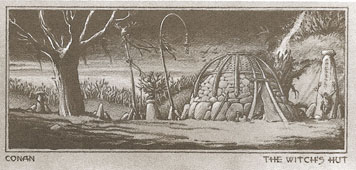
- Thanks! Here is another one for you: I knowthat the movie was almost made in Yugoslavia (in 1980). Do you know what exactly happened back there?
- The official story is that Yugoslavia couldn't provide the necessary modern materials (i.e., fiberglass) we needed to make the film. That may have been partly true; I certainly had a hard time finding art supplies in Zagreb (we eventually had what I needed shipped in from Rome). But I felt the unique and spectacular locations in Yugoslavia more than made up for any inconveniences or discomfort we might have encountered while making our movie.
From what I could discern, here is what actually happened: we had a devious little English accountant whose wife was Spanish, I believe, with a home in Spain. He wanted to be close to his home for the duration of the production, so he began lobbying hard to get out of Yugoslavia and move the production to Spain. He started voicing a regular series of complaints about Yugoslavia and how hopeless and expensive it was going to be to shoot there, how easy it would be to make the film in Spain and how much cheaper it would be to base ourselves in Madrid.
He was certainly right about the ease of film making in Spain. They have great prop houses there, great film crews and a thriving film industry.
Except for me, there was very little resistance from the production in regards to moving. I loved Zagreb and Yugoslavia but I think I was alone in that regard. I was also the only person on the film who bothered to regularly step out of the hotel and explore the city, its food and its culture. I still think it was a big mistake moving to Spain. I love Spain, I loved living and working there — but Yugoslavia's dramatic locations would ultimately have been much better for the film in my opinion.
As John Milius often states, "Pain is temporary; the film is forever."
- How far exactly went the production in Yugoslavia?
- We had a pretty full art department there. There was Ron Cobb, myself, Pierluigi Basile (from Italy), Benjamin Fernandez (from Spain) and several other Italians, as well as a handful of Yugoslavians. We were working under very crude conditions at Jadran Studios.
- How long did the production stay there?
- We were there for just a few months.
- Were some of the sets constructed (or did the production left before that)?
- I don't recall any construction but I may be mistaken. I doubt it, though.
- Was any (preliminary) footage ever shot there?
- There was footage shot of the potential locations. Since the actors weren't there yet, there was no footage actually shot for use in the film.
- You saw the scouted locations and the Jadran Film Studios in Zagreb... Could you possibly describe how different would the CONAN movie have been (visually) if shot in Yugoslavia?
- The Yugoslavian locations were much more spectacular, mysterious and otherworldly than what we got in Spain. One location looked as if it was at the end of the earth. Powerful!
- I remember Ron Cobb saying in some magazine that an amphitheatre set at Thulsa Doom's Mountain of Power (for which he had found a wonderful natural cave in Yugoslavia) did not make it into the picture when the production was relocated in Spain...
- There were (are) lots of great caves in Yugoslavia. Ron always took our locations into consideration when designing our sets so that they all looked natural in their settings.
- Other than Yugoslavia and Spain, do you know (or remember) what countries were considered (even briefly) as possible filming locations for the first CONAN movie?
- It was Yugoslavia from the day I started. I think that one of the reasons William Smith got cast (besides my constant insistence) was because he speaks Serbo-Croatian.
After deciding Yugoslavia wouldn't work for us, we briefly considered Rome and the Cinecittà Studios. Dino DeLaurentiis, of course, has a history there. But the Red Brigade was at the height of its terrorism. The production was informed that there would be no guarantees of our safety and that there would be a real danger of Arnold being kidnaped or of our shot film negatives being stolen and held for ransom.
So Spain it was...
- I heard/read about Germany (Black Forest), Russia, Red China and even Africa (!) as considered filming locations/countries, but I assume these (if true?) were just ideas tossed before you started working on the project...
- I think I recall hearing Black Forest mentioned as well. I don't think it was ever seriously considered, though. The rest I never heard mentioned.
- Now, Canada (British Columbia) is listed in the actual filming locations on the IMDB but I guess they are wrong, right? Or was some footage possibly shot there?
- I doubt if any footage was shot in B.C.... It seems highly unlikely. I must add, though, that my very next film, FIRST BLOOD (the first RAMBO movie), was shot in B.C. with Buzz Feitshans (the CONAN line producer) as line producer. I storyboarded the action sequences for the film.
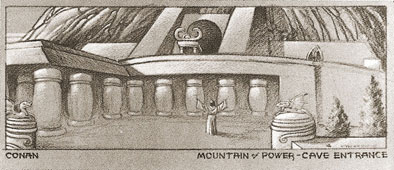
TO BE CONTINUED...
Interview by: MightyMcT
All artwork on this page © William Stout. All Rights Reserved. Used with permission. |
|
|
|
 |

